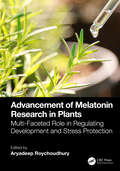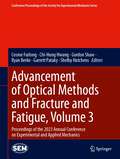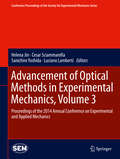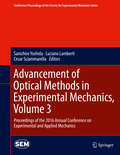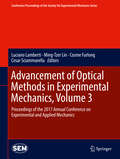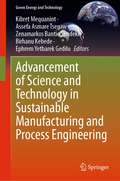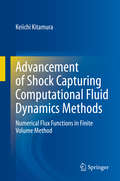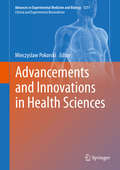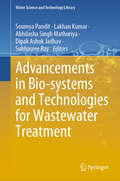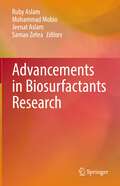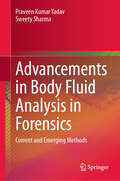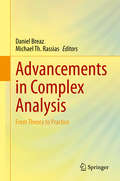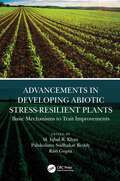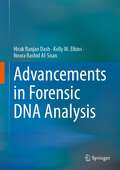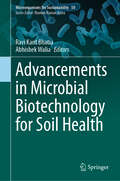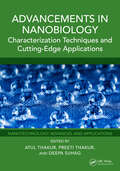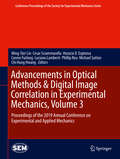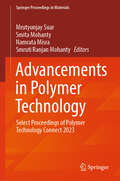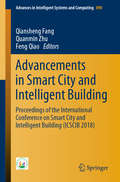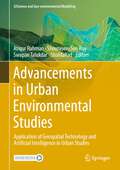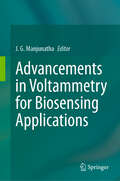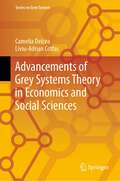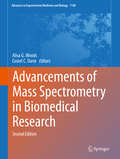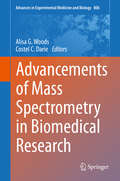- Table View
- List View
Advancement of Melatonin Research in Plants: Multi-Faceted Role in Regulating Development and Stress Protection
by Aryadeep RoychoudhuryMelatonin (N-acetyl-5-methoxytryptamine) is a widely studied biomolecule, and its function has been investigated in bacteria, mammals, birds, amphibians, reptiles, fish and plants. Melatonin research in plants the last five years has attained an exponential growth phase and the number of publications related to phytomelatonin has significantly increased in present times. All this research is directed towards establishing multifarious roles of melatonin in plants, including the promotion of seed germination and seedling growth, influencing plant development and senescence, alteration of flowering and fruiting time and grain yield, modulating circadian rhythms, improving resistance against biotic stress as well as tolerance to abiotic stress, reducing oxidative stress, and stimulating plant immune response. However, to date, an exhaustive book, solely and exclusively dedicated to melatonin research on various aspects of plant biology, has not been published by any renowned publisher or is available in the market. Keeping all these facts in mind, this book aims to compile the most recent developments in the arena of melatonin-mediated regulation of plant physiology under optimal and sub-optimal conditions. This book will initiate and introduce the readers to the state-of-the-art developments and trends in this field of study and will largely cater to the scientific need of scientists engaged in melatonin research across the globe. The book will be unique of its kind and will draw the attention of scientific and research communities engaged in the field of melatonin research.The key features of this book: Authors will address the topics which would provide advances in the understanding of diverse functions of melatonin in plants, encompassing almost all the aspects that have been investigated so far Integrate the overall mechanistic function of melatonin, genomics and proteomics tools, and genetic engineering to manipulate endogenous melatonin levels, thus giving a holistic view of plant-level studies under normal or challenging situations Largely help the readers to design future research programs in exploiting melatonin as a protective agent to develop climate-resilient and pathogen-resistant plants Benefit the crop protection program and ensure food security Chapters will be supplemented with ample illustrations and figures This book will be beneficial to research scholars and Ph.D. students involved in melatonin research and working on stress physiology, stress proteins, genomics, proteomics and genetic engineering in different universities and research institutes all over the world. The book can also be used as an advanced reference book for the coursework of research and master’s level students. It will be of use to people involved in improving plant growth and yield, as well as the performance of plant species in the face of climate change and pathogen infection, using melatonin as the prime protective agent and signaling molecule. Although the book will directly benefit the academic and scientific community, it will also indirectly draw the attention of industries or companies that manufacture or sell chemical products, since the book will highlight in detail the antioxidative potential of melatonin. This will create impetus at the industrial level for the isolation and synthesis of melatonin as a beneficial chemical agent. Applying melatonin as an ameliorating agent against different stresses at the field level will also increase the demand for this chemical among the farmers and will promote large-scale sales and utilization of melatonin for ensuring crop protection and increasing yield.
Advancement of Metal Oxide Materials for Photocatalytic Application: Selected Strategies to Achieve Higher Efficiency
by Vitaly GurylevThis book investigates applicability of various emerging strategies to improve important properties and features of metal oxide materials that can be used further to advance their photocatalytic and photoelectrochemical performances. The range of discussed strategies includes introduction of intrinsic and extrinsic deficiencies, fabrication of heterojunction and utilizing of metal nanoparticles in the form of deposited or embedded formations. Each of them is addressed as separate case in order to reach full and comprehensive assessment of their most fundamental principles and basics as well as accessing pivotal advantages and disadvantages. Furthermore, additional discussion is dedicated to achieving thorough awareness over methods and experimental protocols that are used to realize them and also probing changes which they induce in electronic and geometrical configurations of metal oxide materials. It is believed that this book might become a valuable addition to extend further current knowledge about photocatalysis and material processing.
Advancement of Optical Methods and Fracture and Fatigue, Volume 3: Proceedings of the 2023 Annual Conference on Experimental and Applied Mechanics (Conference Proceedings of the Society for Experimental Mechanics Series)
by Cosme Furlong Gordon Shaw Garrett Pataky Chi-Hung Hwang Shelby Hutchens Ryan BerkeAdvancement of Optical Methods and Fracture and Fatigue, Volume 3 of the Proceedings of the 2023 SEM Annual Conference & Exposition on Experimental and Applied Mechanics, the third volume of five from the Conference, brings together contributions to this important area of research and engineering. The collection presents early findings and case studies on fundamental and applied aspects of Experimental Mechanics, including papers in the following general technical research areas:Extreme EnvironmentsInterfacial FractureIntegration of Models & ExperimentsMechanics of Energy & Energetic MaterialsIntegration of Models & ExperimentsIn Situ Techniques for Fatigue & FractureMicroscale & Microstructural Effects on Mechanical BehaviorCharacterization Across Length ScalesExtreme Conditions & Environmental EffectsDamage, Fatigue and FractureStructure, Function and Performance
Advancement of Optical Methods in Experimental Mechanics, Volume 3: Proceedings of the 2014 Annual Conference on Experimental and Applied Mechanics (Conference Proceedings of the Society for Experimental Mechanics Series)
by Helena Jin Sanichiro Yoshida Cesar Sciammarella Luciano LambertiAdvancement of Optical Methods in Experimental Mechanics, Volume 3: Proceedings of the 2014 Annual Conference on Experimental and Applied Mechanics, the third volume of eight from the Conference, brings together contributions to this important area of research and engineering The collection presents early findings and case studies on a wide range of optical methods ranging from traditional photoelasticity and interferometry to more recent DIC and DVC techniques, and includes papers in the following general technical research areas: · Advanced optical methods for frontier applications · Advanced optical interferometry · Optical measurement systems using polarized light · Optical methods for advanced manufacturing · Digital image correlation · Optical methods at the micro/nano-scale · Three-dimensional imaging and volumetric correlation · Imaging methods for thermomechanics applications · Opto-acoustical methods in experimental mechanics · Optical measurements in challenging environments · Optical methods for inverse problems · Advances in optical methods
Advancement of Optical Methods in Experimental Mechanics, Volume 3: Proceedings of the 2016 Annual Conference on Experimental and Applied Mechanics (Conference Proceedings of the Society for Experimental Mechanics Series)
by Sanichiro Yoshida Cesar Sciammarella Luciano LambertiAdvancement of Optical Methods in Experimental Mechanics, Volume 3 of the Proceedings of the 2016 SEM Annual Conference & Exposition on Experimental and Applied Mechanics, the third volume of ten from the Conference, brings together contributions to this important area of research and engineering. The collection presents early findings and case studies on a wide range of optical methods ranging from traditional photoelasticity and interferometry to more recent DIC and DVC techniques, and includes papers in the following general technical research areas: Advances in Digital Image Correlation Challenging Applications of DIC Uncertainty Analysis & Improvements to DIC Accuracy Photoelasticity, Interferometry, & Moire Methods Applications of Stereovision Inverse Methods at High Strain Rates Inverse Methods in Plasticity
Advancement of Optical Methods in Experimental Mechanics, Volume 3: Proceedings of the 2017 Annual Conference on Experimental and Applied Mechanics (Conference Proceedings of the Society for Experimental Mechanics Series)
by Cosme Furlong Cesar Sciammarella Luciano Lamberti Ming-Tzer LinAdvancement of Optical Methods in Experimental Mechanics: Proceedings of the 2013 Annual Conference on Experimental and Applied Mechanics, the third volume of eight from the Conference, brings together contributions to this important area of research and engineering The collection presents early findings and case studies on a wide range of optical methods ranging from traditional photoelasticity and interferometry to more recent DIC and DVC techniques, and includes papers in the following general technical research areas: Optical metrology and displacement measurements at different scales Digital holography and experimental mechanics Optical measurement systems using polarized light Surface topology Digital image correlation Optical methods for MEMS and NEMS Three-dimensional imaging and volumetric correlation Imaging methods for thermomechanics applications 3D volumetric flow measurement Applied photoelasticity Optical residual stress measurement techniques Advances in imaging technologies
Advancement of Science and Technology in Sustainable Manufacturing and Process Engineering (Green Energy and Technology)
by Kibret Mequanint Assefa Asmare Tsegaw Zenamarkos Bantie Sendekie Birhanu Kebede Ephrem Yetbarek GediluThis book presents current research on sustainable development issues and recent manufacturing and process engineering advances. Topics covered range from postharvest technologies to sustainable utilization of natural resources and supply chain integration to the design of renewable energy systems. The book provides researchers, engineers, industry professionals, graduate students, and practitioners with state-of-the-art research on the efforts being made toward sustainability in developing countries.
Advancement of Shock Capturing Computational Fluid Dynamics Methods: Numerical Flux Functions in Finite Volume Method
by Keiichi KitamuraThis book offers a compact primer on advanced numerical flux functions in computational fluid dynamics (CFD). It comprehensively introduces readers to methods used at the forefront of compressible flow simulation research. Further, it provides a comparative evaluation of the methods discussed, helping readers select the best numerical flux function for their specific needs.The first two chapters of the book reviews finite volume methods and numerical functions, before discussing issues commonly encountered in connection with each. The third and fourth chapter, respectively, address numerical flux functions for ideal gases and more complex fluid flow cases— multiphase flows, supercritical fluids and magnetohydrodynamics. In closing, the book highlights methods that provide high levels of accuracy.The concise content provides an overview of recent advances in CFD methods for shockwaves. Further, it presents the author’s insights into the advantages and disadvantages of each method, helping readers implement the numerical methods in their own research.
Advancements and Innovations in Health Sciences (Advances in Experimental Medicine and Biology #1211)
by Mieczyslaw PokorskiThis book focuses on recent advances regarding clinical conditions and ailments whose mechanisms remain unclear, limiting our ability to treat them. The respective chapters address a range of multidisciplinary topics related to timely or emergent research areas, such as osteoporosis in postmenopausal women, the optimal surgical procedures for vertebral compression fractures, novel rehabilitative approaches in pelvic muscle training in case of urinary incontinence, and a rational approach to balneotherapy not only for the skin but also other organ systems disorders. Alterations in the endocrine function during strenuous physical activity at high altitude – a multi-stressor environment comprising hypobaric hypoxia, exercise, and nutritional changes – are presented as well. Other articles provide evidence-based insights into the diagnosis, mechanisms, and clinical course of respiratory infections in children such as bronchiolitis, pneumonia, and influenza. Finally, the pros and cons of e-health are discussed; a rapidly growing area based on the use of information and communication technology to streamline the flow of health information and patient-healthcare provider connections. The content is a well-structured blend of research and practical aspects, as well as updates on cutting-edge developments. All these essential topics are presented in a format suitable for medical professionals engaged in day-to-day patient care and therapy, as well as researchers, academics, and physiotherapists.
Advancements in Bio-systems and Technologies for Wastewater Treatment (Water Science and Technology Library #118)
by Soumya Pandit Subhasree Ray Abhilasha Singh Mathuriya Lakhan Kumar Dipak Ashok JadhavThis book explains the main problems of industrial wastewater treatments and how they are being treated by innovative biological processes. The need for clean water in developing countries has become difficult to achieve as a result of globalization and industrialization and because of an increase in population, urbanization, and per capita water use. Residential, commercial, industrial, and educational institutions produce immense amounts of wastewater. Wastewater is treated to extract toxins to produce processed effluent by physical, chemical, and biological processes. Most of these innovative treatment systems are membrane filtration, advanced oxidation processes, and electrochemical approaches, which are strongly committed to offering solutions to help protect public health and the environment. For wastewater treatment, different forms of bioreactors are used which are reliable, cost-efficient, and effective in removing a wide variety of contaminants. This book outlines the capacity of various bioreactors that are most widely used for the treatment of different industrial and domestic wastewater, such as a rotating biological contactor, biological fluidized bed reactor, packed bed reactor, membrane bioreactor, continuous stirred tank bioreactor, up-flow anaerobic sludge blanket reactor, and photobioreactor, etc. Despite this, the acceptance of these technologies and their commercialization on an industrial scale, the performance is still limited. Therefore, a broader use of cost-effective in situ remedial approaches to natural phenomena like bioremediation is needed. The role of numerous bioreactors in industrial effluent treatment has, including recent developments, also been explored in depth. Furthermore, it includes the operational factors affecting their performances, advances in their architectural design, their amalgamation with the existing setup, scale-up studies, life cycle assessment of those reactors, materials and cost analysis, etc. This information helps the reader to understand the insight into the mechanism, pros and cons, moreover efficient utilization, and commissioning of bioreactors.
Advancements in Biosurfactants Research
by Mohammad Mobin Jeenat Aslam Ruby Aslam Saman ZehraThis book presents numerous uses of biosurfactants as potential alternatives to synthetic surfactants in food, textile, biomedical and therapeutic applications as well as in bioremediation and waste management. Divided into four parts, the book explores a wide range of biosurfactants as sustainable materials, starting with an overview of biosurfactants’ production, in which readers will find topics such as characterization, purification, sustainable production, biodegradation, and cytotoxic aspects of biosurfactants. Part 2 presents the latest applications of biosurfactants in food and textile industries, as well as their application in nanoparticle synthesis, heavy metal remediation, drug absorption, waste treatment, agriculture management, marine sediment remediation of organic pollutants, emulsification and biofuel production, and as anti-corrosive agents. Part 3 traces current biomedical applications of biosurfactants, including their use as biocidal, wound healing, and anti-tumour agents. In this part, readers will also discover further applications of biosurfactants in oral cavity care, and biofilm prevention and disruption. The final part of the book discusses the main advantages and disadvantages of biosurfactants over synthetic surfactants, the current challenges in biosurfactant research, and prospects for their commercialization. This book will be a valuable resource for students, scholars and researchers working in the fields of colloidal and interface science, chemistry and chemical engineering. Professionals and scholars alike will appreciate the latest research findings that it presents.
Advancements in Body Fluid Analysis in Forensics: Current and Emerging Methods
by Praveen Kumar Yadav Sweety SharmaThis book addresses the forensic examination of body fluids. The chapters that follow begin by laying out conventional examination methods for each body fluid and continues to more advanced and modern methods for detection and identification. It discusses the production, composition, and the forensic examination of each body fluid found in a human body in detail. It is ideal for graduate students and new professionals in the field of forensic science.
Advancements in Complex Analysis: From Theory to Practice
by Michael Th. Rassias Daniel BreazThe contributions to this volume are devoted to a discussion of state-of-the-art research and treatment of problems of a wide spectrum of areas in complex analysis ranging from pure to applied and interdisciplinary mathematical research. Topics covered include: holomorphic approximation, hypercomplex analysis, special functions of complex variables, automorphic groups, zeros of the Riemann zeta function, Gaussian multiplicative chaos, non-constant frequency decompositions, minimal kernels, one-component inner functions, power moment problems, complex dynamics, biholomorphic cryptosystems, fermionic and bosonic operators. The book will appeal to graduate students and research mathematicians as well as to physicists, engineers, and scientists, whose work is related to the topics covered.
Advancements in Developing Abiotic Stress-Resilient Plants: Basic Mechanisms to Trait Improvements
by Khan, M. Iqbal R.Plants often encounter abiotic stresses including drought, salinity, flooding, high/low temperatures, and metal toxicity, among others. The majority of these stresses occur simultaneously and thus limit crop production. Therefore, the need of the hour is to improve the abiotic stresses tolerance of crop plants by integrating physiology, omics, and modern breeding approaches. This book covers various aspects including (1) abiotic stress responses in plants and progress made so far in the allied areas for trait improvements, (2) integrates knowledge gained from basic physiology to advanced omics tools to assist new breeding technologies, and (3) discusses key genes, proteins, and metabolites or pathways for developing new crop varieties with improved tolerance traits.
Advancements in Forensic DNA Analysis
by Hirak Ranjan Dash Kelly M. Elkins Noora Rashid Al-SnanThis textbook for undergraduate and postgraduate students discusses advancements in forensic DNA analysis since early texts were published. It presents conventional and latest serological and molecular biological methods for body fluid identification. This book also describes the applications and advantages of next-generation sequencing (NGS) compared to conventional methods in forensic DNA analysis. It also defines the growing importance, techniques, and applications for the analysis of non-human DNA in forensic sciences. Further, the book examines the role of DNA databases in forensic interpretation and criminal investigations. Towards the end, this textbook reviews the application of forensic DNA technology in analyzing real-time casework samples and presents the guidelines, ethical issues, and other challenges of forensic DNA analysis. This textbook is an essential resource for students and practitioners interested in gaining knowledge of up-to-date forensic techniques and their applications in forensic DNA analysis.
Advancements in Microbial Biotechnology for Soil Health (Microorganisms for Sustainability #50)
by Ravi Kant Bhatia Abhishek WaliaThis edited book covers the latest trends to improve soil health. It provides an easy-to-understand information to the readers. This book acts as a reference book for various agronomists and research scholars working in the field of agriculture. This edited book covers advanced technologies and practices carried out worldwide to improve soil health. In the present scenario, it is very important to save soil health and replenish it in a sustainable manner from various anthropogenic hazards. As soil is the source to almost all lives on earth and it is duty, the scientific community is developing ways to disseminate and communicate the most recent advancements to restore its health. Content of the book is designed in such a way that it provides a compressive information to the readers to restore the soil health that will ultimately help to improve the health of microbes, animals as well as plants that thrive in the soil and ultimately the quality of life of human being. This book helpsresearch scholars and teachers working in agriculture, horticulture, and environmental management by utilizing advances in microbiology and biotechnology. It is of interest to undergraduate and graduate students, teachers, researchers, environmentalists, agriculture and horticulture scientists, capacity builders, policy makers and all other stakeholders.
Advancements in Nanobiology: Characterization Techniques and Cutting-Edge Applications (Nanotechnology Advances and Applications)
by Atul Thakur Preeti Thakur Deepa SuhagThis book presents the design, synthesis, characterization, and advanced applications of nanomaterials and nanodevices in biology and medicine. It begins with an introduction to nanobiology, providing readers with insights into the significance of this emerging field. The book covers methods for characterizing nanoparticles, including Fourier transform infrared spectroscopy (FTIR), scanning electron microscopy (SEM), transmission electron microscopy (TEM), atomic force microscopy (AFM), X-ray diffraction (XRD), and other spectroscopy techniques. It also explores the applications of nanoparticles in optical coherence tomography, biosensors, neuroscience, genetic engineering, and cell biology. It explores various applications of nanoparticles, including spectroscopy, Raman imaging, molecular nanodevices, bioimaging techniques, regenerative medicine, cancer research, bio-molecular analysis, nanofabrication, multi-modal imaging, and microfluidic platforms. Additionally, it addresses important considerations such as nanotoxicology and safety in nanobiology. The book concludes by discussing future perspectives and potential advancements in the field, making it a valuable resource for researchers, students, and professionals exploring the transformative impact of nanobiology on science and medicine.Key Features: Covers fundamental concepts and advanced applications of nanomaterials and nanodevices in the fields of biology and medicine Presents advanced nanoparticle characterization techniques, including FTIR, SEM, TEM, AFM, and XRD Examines various biological applications of nanoparticles in diagnostics, neurobiology, genetic engineering, regenerative medicine, and cancer research Emphasizes the role of nanoparticles in understanding biological processes at the molecular level and developing innovative solutions for biomedical applications Provides insights into the toxicity issues and mechanisms underlying the toxicity of nanoparticles
Advancements in Optical Methods & Digital Image Correlation in Experimental Mechanics, Volume 3: Proceedings of the 2019 Annual Conference on Experimental and Applied Mechanics (Conference Proceedings of the Society for Experimental Mechanics Series)
by Cosme Furlong Cesar Sciammarella Michael Sutton Horacio D. Espinosa Luciano Lamberti Ming-Tzer Lin Phillip Reu Chi-Hung HwangAdvancement of Optical Methods & Digital Image Correlation in Experimental Mechanics, Volume 3 of the Proceedings of the 2019 SEM Annual Conference & Exposition on Experimental and Applied Mechanics, the third volume of six from the Conference, brings together contributions to this important area of research and engineering. The collection presents early findings and case studies on a wide range of optical methods ranging from traditional photoelasticity and interferometry to more recent DIC and DVC techniques, and includes papers in the following general technical research areas: DIC Methods & Its ApplicationsPhotoelsticity and Interferometry ApplicationsMicro-Optics and Microscopic SystemsMultiscale and New Developments in Optical MethodsDIC and its Applications for Inverse Problems
Advancements in Polymer Technology: Select Proceedings of Polymer Technology Connect 2023 (Springer Proceedings in Materials #57)
by Smita Mohanty Mrutyunjay Suar Namrata Misra Smruti Ranjan MohantyThe book presents the select proceedings of International Conference on Polymer Technologies 2023. It explores cutting-edge polymeric materials, their impact on diverse industries, and their role in shaping a more sustainable future. Various topics covered in this book are smart polymers, nanocomposites, biodegradable materials, and allied fields. The book will be useful for researchers and professionals working in the areas of materials engineering.
Advancements in Smart City and Intelligent Building: Proceedings Of The International Conference On Smart City And Intelligent Building (ICSCIB 2018) (Advances in Intelligent Systems and Computing #890)
by Quanmin Zhu Feng Qiao Qiansheng FangThe book entitled “Advancements in Smart City and Intelligent Building” is the Proceedings of the International Conference on Smart City and Intelligent Building (ICSCIB 2018) held in Hefei, China, September 15-16, 2018. It contains 58 papers in total categorized into 8 different tracks, on Building Energy Efficiency, Construction Robot and Automation, Intelligent Community and Urban Safety, Intelligentialization of Heating Ventilation Air Conditioning System, Information Technology and Intelligent Transportation Systems, New Generation Intelligent Building Platform Techniques, Smart Home and Utility, and Smart Underground Space, which cover a wide range areas of smart cities and intelligent buildings. <p><p> ICSCIB2018 provided an international forum for professionals, academics, and researchers to present the latest developments from interdisciplinary theoretical studies, computational algorithm developments and engineering applications in smart cities and smart buildings. This academic event featured many opportunities to network with colleagues from around the world in a wonderful environment. Its program covered invitation and presentations from scientists, researchers, and practitioners who have been working in the related areas to establish platforms for collaborative research projects in these fields. The conference invited leaders from industry and academia to exchange and share their experiences, present research results, explore collaborations and to spark new ideas, with the aim of developing new projects and exploiting new technology in these fields, and bridge theoretical studies and emerging applications in various science and engineering branches. <p> This book addresses the recent development and achievement in the field of smart city and intelligent building. It is primarily intended for researchers and students for undergraduate and postgraduate programs in the background of multiple disciplines including computer science, information systems, information technology, automatic control and automation, electrical and electronic engineering, and telecommunications who wish to develop and share their ideas, knowledge and new findings in smart city and intelligent building.
Advancements in Urban Environmental Studies: Application of Geospatial Technology and Artificial Intelligence in Urban Studies (GIScience and Geo-environmental Modelling)
by Shouraseni Sen Roy Atiqur Rahman Swapan Talukdar ShahfahadAccording to UN estimates, approximately nearly half of the world's population now lives in cities and that figure is expected to rise to almost 70% by 2050. Cities now account for around 70% of worldwide greenhouse gas emissions, and this percentage is predicted to rise in the near future as a result of projected increases in global urbanization patterns. It is widely acknowledged that irrational urban planning and design can increase emissions while also exacerbating threats and risks, resulting in a slew of environmental issues such as urban heat islands, air pollution, flooding, amongst other issues, as well as environmental, social, and economic losses. Therefore, these concerns must be addressed promptly in order to cope up with these rising difficulties and make urban environments safer for residents. With the advancement of remote sensing technology and the use of current remote observation systems, urban data science, remote sensing, and artificial intelligence (AI), modeling and quantifying emergent difficulties in urban regions and urban systems have become easy. They aid in the quantitative analysis of urban shape, functions, and human behavior in cities. Harvesting data, developing models, and suggesting new methodologies will be aided by combining urban ecology with new breakthroughs in data science. This book is of great value to a diverse group of academicians, scientists, students, environmentalists, meteorologists, urban planners, remote sensing and GIS experts with a common interest in geospatial sciences within the earth environmental sciences, as well as human and social sciences.
Advancements in Voltammetry for Biosensing Applications
by J. G. ManjunathaThis book presents a detailed description of the recent advancements in voltammetry for biosensing applications. This book discusses the emerging research trends in the preparation of voltammetry-based electrochemical sensors for their applications in the analysis of medicinal, industrial, environmental, agricultural and food-related biological compounds. Living life is fundamentally influenced by the products utilized in day-to-day life, such as air, soil, water, food, environment, agriculture, and so on. The concentrations of the organic and inorganic biomolecules in these products may cause various problems to living beings which makes it necessary to analyze the biomolecules. The compactness of electrochemical approaches makes them well suited for on-site analysis. Voltammetric techniques like linear sweep voltammetry (LSV), cyclic voltammetry (CV), differential pulse voltammetry (DPV), square wave voltammetry (SWV), amperometry, and other methods give precise information about the analytes under study. Electrochemical approaches have several advantages in the investigation of significant organic and inorganic biomolecules because of their high sensitivity and selectivity, low detection limits, good adaptability, simplicity to use, and lower cost for instrumentations. Voltammetric methods lead to an in-depth understanding of the reaction kinetics and reaction mechanisms underlying the electrochemical reactions of the bioactive molecules, making them perfect tools for bio sensing applications. These features have resulted in the successful application of voltametric biosensing in the analysis of metal ions, hormones, vitamins, amino acids, agriculturally important and hazardous compounds, environmentally important and hazardous compounds, medicinal compounds, and so on. This book is targeted at scientific researchers in the field of electroanalytical chemistry and aims to inspire them to produce highly sensitive voltametric devices for biosensing applications. It also envisions to motivate researchers from other fields to carry out concurrent investigations in this newly emerging interdisciplinary research area i.e. voltammetric biosensing.
Advancements of Grey Systems Theory in Economics and Social Sciences (Series on Grey System)
by Camelia Delcea Liviu-Adrian CotfasThis book focuses on the main advancements made in the economics and social sciences field through the use of grey systems theory. As a result, it addresses both the state of the art and the applications of grey systems theory in economics and social sciences. The book is structured in eight main chapters, covering the following topics: the state of the art in the grey systems theory research in economics and social sciences, which includes a bibliometric analysis, a selection of the most well-cited papers in the field, and a selection of applications in which the grey systems theory is used in the areas of suppliers selection, risk assessment, public opinion assessment, linear programming, complex projects management, social media analysis, and natural language processing Each chapter gives an overview of a particular economic or social sciences topic, providing an explanation on the main terms and methods used for solving the problem, including the notations, terminology, and the needed steps to solve it. A practical application is presented in most of the chapters, while in the others, a series of case studies are presented from the literature and discussed in depth in terms of methods used and advantages brought by each of these methods. The last chapter discusses the hybridization cases in which the grey systems theory has been or can be successfully used along with other artificial intelligence methods and techniques for a more advanced analysis in the economics and social sciences field. The reasoning and the explanations used in the book are easy to understand for the interested persons who are not familiar to the field and want to learn more related on how the grey systems theory can be applied to economics and social sciences. As for the experts in this field, this book can be a good referral point for developing new areas of research by combining the advantages of the grey systems theory with other theories within the field.
Advancements of Mass Spectrometry in Biomedical Research (Advances in Experimental Medicine and Biology #1140)
by Alisa G. Woods Costel C. DarieThis volume explores the use of mass spectrometry for biomedical applications. Chapters focus on specific therapeutic areas such as oncology, infectious disease, and psychiatry. Additional chapters focus on methodology, technologies and instrumentation, as well as on analysis of protein-protein interactions, protein quantitation, and protein post-translational modifications. Various omics fields such as proteomics, metabolomics, glycomics, lipidomics, and adductomics are also covered. Applications of mass spectrometry in biotechnological and pharmaceutical industry are also discussed. This volume provides readers with a comprehensive and informative manual that will allow them to appreciate mass spectrometry and proteomic research, but also to initiate and improve their own work. This book acts as a technical guide as well as a conceptual guide to the newest information in this exciting field.
Advancements of Mass Spectrometry in Biomedical Research (Advances in Experimental Medicine and Biology #806)
by Alisa G. Woods Costel C. DarieThis volume explores the use of mass spectrometry for biomedical applications. Chapters focus on specific therapeutic areas such as oncology, infectious disease and psychiatry. Additional chapters focus on methodology as well as new technologies and instrumentation. This volume provides readers with a comprehensive and informative manual that will allow them to appreciate mass spectrometry and proteomic research but also to initiate and improve their own work. Thus the book acts as a technical guide but also a conceptual guide to the newest information in this exciting field. Mass spectrometry is the central tool used in proteomic research today and is rapidly becoming indispensable to the biomedical scientist. With the completion of the human genome project and the genomic revolution, the proteomic revolution has followed closely behind. Understanding the human proteome has become critical to basic and clinical biomedical research and holds the promise of providing comprehensive understanding of human physiological processes. In addition, proteomics and mass spectrometry are bringing unprecedented biomarker discovery and are helping to personalize medicine.
